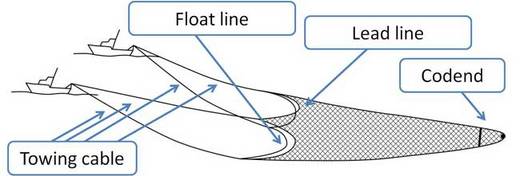
Fishing Techniques
Fishing Techniques
Fishing techniques include both passive and active gears.
Passive fishing gears: when the target species move into or towards the gear. In the Chioggia’s fishing fleet, passive gears include static fishing gears. long line and fishing line.
Active fishing gears: when they are propelled or towed in pursuit of the target species. In the Chioggia’s fishing fleet, active gears include different types of trawls, seine, pursse seine, hydraulic dredge, mechanical dredge, spear.
Static fishing gears
Two types of fishing gears are licensed as static fishing gears: gill and trammel nets, and trap.
Gill net is constituted by a series of panels of meshes with a lead foot-rope and a headline with floats. The number of panels can vary.
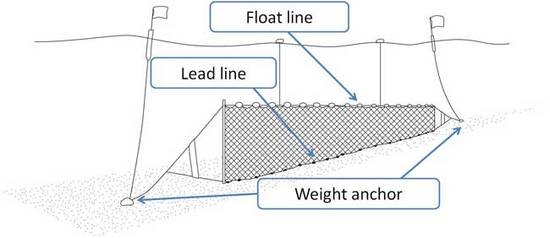
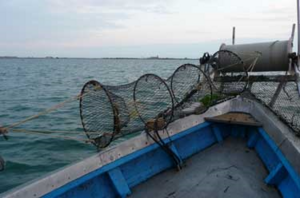
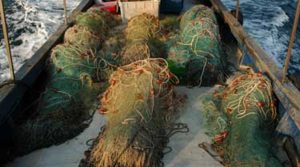

Meshes are uniform in size and shape and therefore highly selective for a particular size class of fish. Fish become snagged by their gill opercula, fins or scales as they try to swim through the net. Gill net can be set at different depth, from the bottom to the surface of the water column. Trammel net differ from gill net because they incorporate three layers of netting: an inner small meshed net between layers of large meshed net. Trammel net is usually set on the seabed. In addition, a combination of the two types of nets is used by vessels of Chioggia’s fleet. The net is composed by a trammel net on the upper part, and a gill net on the lower one.
Two types of traps are used by vessels of Chioggia’s fleet. A first type, called “nasse”, consist in a trap composed by one chamber of non-return. These traps are set in lines, formed by approximately 25 traps, anchored to the bottom, in coastal waters, targeting mainly cuttlefish during their breeding season. A different type of traps, called locally “cogolli”, is constituted by several chambers of non-return. Traps are attached to a wall of net that directs the fish to the entrance of the trap. This type of traps is used inside the lagoon, targeting different species.
Long line
The long-line consists of a length of line, wire or rope, to which baited hooks are attached via shorter lengths of line.
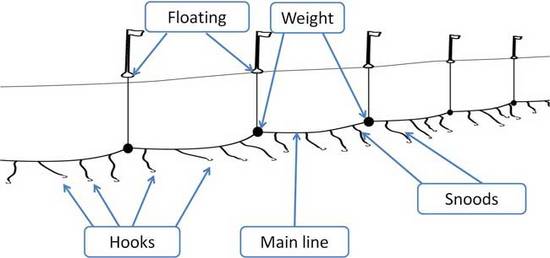
The main line is provided with buoys and weights, whose relative amount determines the depth at which the long-line fishes. The long-line can be set close to the bottom, anchored at each end and market with buoys at the surface, or close to the surface, drifting or kept attached to the vessel. Long-lines set close to the bottom or at water surface target different species, nektobenthic predators the former, pelagic predators the latter. In the Chioggia’s fishing fleet, few vessels use this technique.
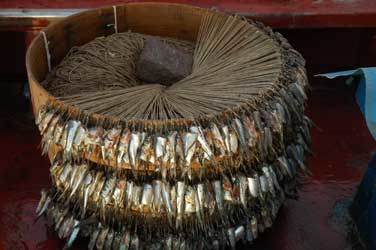
Fishing line
Fishing line consists of hooks attached to a line and provided with a weight. Fishing line can be attached to a fishing rod. Hooks are usually provided with baits, and can be towed or deployed from a still vessel. This fishing technique is frequently used by recreational fishermen.
Trawls
Trawl represents the main fishing technique used by Italian fishing fleets, including the Chioggia’s one.
The nets can have different shapes, and are held open by buoys, attached to the headline, and a weighted foot-rope or a rigid beam.
Trawls can be towed close to the bottom (bottom trawling) or in the water column (pelagic trawling).
-Otter trawls: the net includes two wings, held open by otter boards, and a codend.

The net can be towed at different distances from the bottom, adding more or less weighted foot-ropes. It usually targets benthic species.
-Beam trawls: the net is attached to a rigid beam supported by shoes (four in the Chioggia’s vessels). A modified gear (“rapido”) is used by fishing vessels from Chioggia.

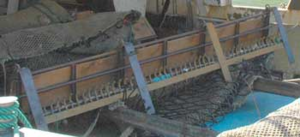
The upper part includes an oblique board, that help in maintaining the net mouth close to the bottom, while lower part is provided with iron teeth (5-7 cm long), that enter into the bottom. A fishing vessel usually tows up to four beam trawls. This technique is frequently used by Chioggia’s fishing fleet and targets scallops, great scallop, and flatfish.
The net mouth is held open thanks to the use of the two vessels, while buoys, attached to the headline, and a weighted foot-rope guarantee the vertical opening. Depending from towing speed and weight of the foot-rope, the net can fish at different depths. Several vessels of the Chioggia’s fishing fleet use this technique, targeting mainly pelagic species like anchovy, sardine, and mackerels.
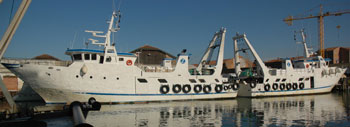
Seine
This gear represent old fishing technique used on shallow sandy bottoms. The net can have variables lengths (from few to hundreds of meters), and includes a coden and two wings. The net is held open by buoys, attached to the headline, and weights, attached to the foot-rope.
The net is set from the shore or deployed by boat at sea and slowly towed. The towing from the shore implies the work of several fishermen. This fishing gear is today rarely used. Even if some fishing boats from Chioggia have the license for this fishing technique, it is not used any more in the area.
Purse seine
Purse seine
The purse seine consists in a very large net held close to the surface by buoys, attached to the headline, and a weighted foot-rope. It is set encircling a school of fish, usually detected suing a sonar. After the set, the net is closed at the foot-rope and then dragged aboard. A light can be used to attract fish. This technique targets mainly pelagic fish, such as anchovy, sardine, mackerels and tuna. In the Chioggia’s fishing fleet, although some vessels have the license, it is not currently employed being substituted by the pelagic trawls.
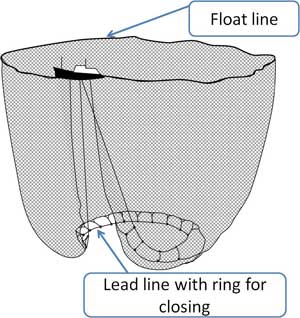
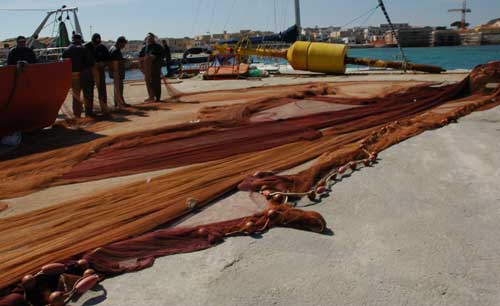
Hydraulic dredge
Hydraulic dredge
Hydraulic dredge (“turbosoffiante”) consist of rigid metal “cage”, equipped with a blade that enters into the bottom.
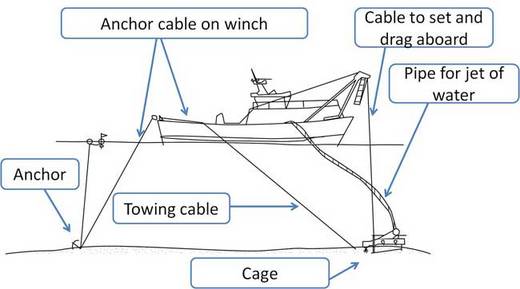
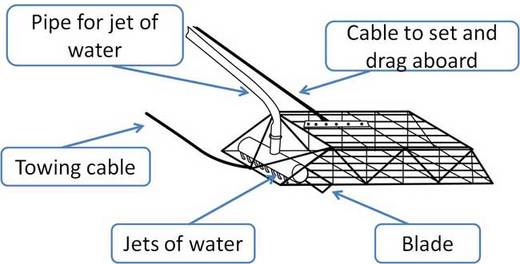
Jets of water, pulled in front of the dredge head, are used to fluidize the sediment and facilitate the penetration into the bottom. The rigid “cage” is deployed from boat bow and towed at reverse. Mesh size of the net can vary, according to the target species, and is regulated by law. Several vessels of the Chioggia’s fishing fleet are licensed to use this fishing technique, and the main target species are bivalves, such as striped venus, jackknives, callista, and the peanut worm, sold as baits.
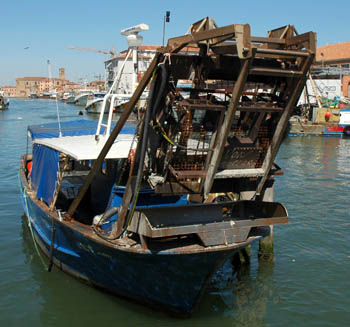
Mechanical dredge
Mechanical dredge consists in a rigid metal frame and a net. The net is towed either in a straight line or in a circle line, exploiting engine power and anchor resistance. Mechanical dredge is towed on soft bottom , targeting bivalves in particular, for the Chioggia’s fishing fleet, clams inside the Venetian Lagoon.
Spear
The spear consists of a stick, of variable length, provided with metal teeth at the end. This gear is today employed mainly by recreational fishermen. In Italian water, it is still used to catch swordfish, in a traditional fishing techniques used in Sicily. Only one fishing vessel of the Chioggia’s fleet has this license.



